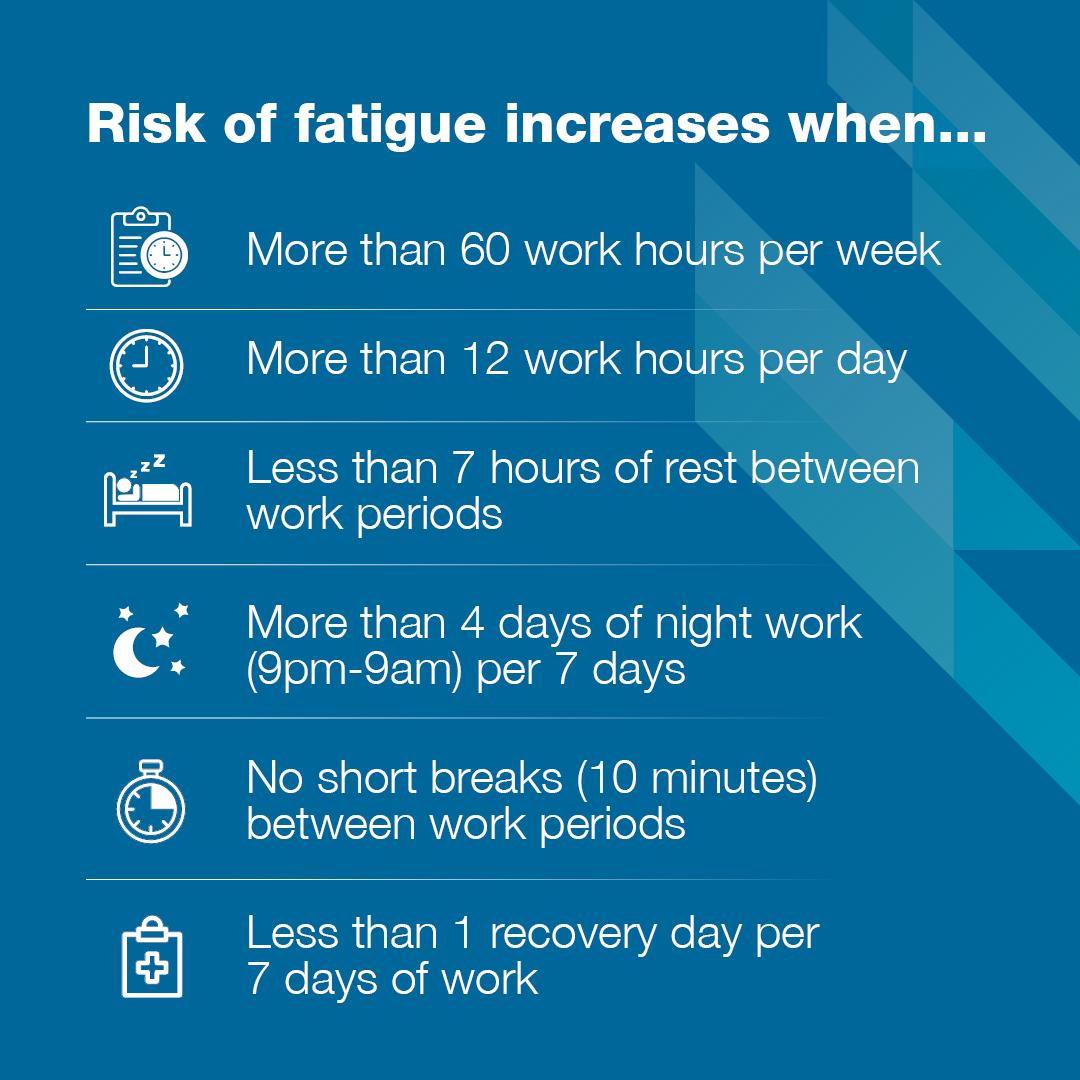
On 1 June 2025, we introduced new requirements for safety management systems (SMS).
These changes affect all domestic commercial vessels. Find out what you need to do.
We are also introducing simplified SMS requirements for smaller, less complex vessels. Check if your vessel is eligible.
Owners and masters must take reasonable steps to ensure their vessel and crew are safe, and this includes mitigating the risks presented by fatigue in the workplace. Involving crew in the management of fatigue is a critical part of this mitigation process.
By understanding the causes and consequences of fatigue we can reduce safety hazards and improve health, wellbeing, and performance across the maritime industry.
What is fatigue?
Fatigue is a state of weariness. It can develop quickly – for example, if you are doing heavy lifting. It can also develop slowly – for example, if you lose an hour of sleep a few nights in a row.
A survey of more than 1000 crew working across a wide range of commercial vessels in Australia found a concerning knowledge gap when it came to identifying and managing fatigue. Of the 1000 survey participants:
- One in three began work on a vessel already in a fatigued state
- 40% had less than six hours of sleep in any given 24-hour period
- Survey participants struggled to identify lesser-known behavioural signs of fatigue like slurred speech and risk taking
- 50% had not received any fatigue management training or guidance.
What happens when you are fatigued?
Fatigued crew are very likely to make mistakes, putting themselves, others and the environment at risk. Working while fatigued has the same effect as driving while over the legal limit, some of the tell-tale signs are:
- Physical: Inability to stay awake (head nodding, microsleeps or falling asleep involuntarily), difficulty with hand-eye coordination, slurred or garbled speech, dropping objects like tools or parts, digestion problems.
- Cognitive: Focusing on trivial problems and neglecting important ones, slow or no response to abnormal or emergency situations, lapses of attention, poor judgement of distance, speed and time, forgetfulness, difficulty concentrating and thinking clearly.
- Behavioural: Decreased tolerance and/or antisocial behaviour, irregular mood changes, ignoring normal checks and procedures, increasing mistakes and carelessness.
Fatigue is a factor that significantly increases the risk of accidents in the workplace. Suffering from fatigue for a prolonged period of time is also associated with serious health conditions like cardiovascular disease, gastrointestinal disease, mental health issues and stress levels.
What causes fatigue and how can you manage it?
Lack of quality sleep, body clock disruptions, work tasks and structure, environmental factors in the workplace, lifestyle including diet and personal responsibilities at home, all influence the onset of fatigue and should be considered as part of a holistic approach to managing fatigue.
Lack of quality sleep
Generally, people need between 7-9 hours of sleep per night to perform adequately and effectively. Any less than this can result in fatigue. Most accidents involving fatigue follow a lack of sleep or poor quality sleep. Poor quality sleep is when your sleep is disturbed by things like light, noise, motion, alcohol, drugs or stress. Fatigue can also accumulate when you do not get extra sleep to make up for lost sleep – sometimes referred to as a ‘sleep debt’.
Mitigation: Work with crew members to examine what a typical 24-hour period looks like for them, factoring in the time spent working and time spent on other activities like commuting and being at home with loved ones. Help them identify a window for sleep, where they can have a minimum guaranteed 7 hours of quality, uninterrupted sleep. The need for this should be communicated with the crew member’s support network, which includes their fellow crewmates and loved ones ashore, and factored into workplace operations as an absolute priority.
Body clock disruptions
Humans have evolved to spend about a third of their lives sleeping. Our body clocks naturally program us to be drowsy in the late afternoon and sleep at night. Shift work is sometimes an unavoidable part of working on the water, which is why body clock disruptions must be carefully managed to reduce the risk of fatigue impacting safety.
Mitigation: If possible, avoid scheduling critical operations between the hours of 3am-6am and 3pm-5pm, when crew are most likely to be drowsy or have an urge to sleep. If that’s not possible due to the nature of your operation, ensure other mitigation strategies are in place as outlined in this guidance hub.
Work and job design
Common features of work and job design that lead to fatigue are:
- A long workday
- Physical tasks
- Boring or repetitive work
- Few or no breaks
- A pay system that encourages long hours
- Inadequate time for sleep between work operations
- Unpredictable work schedules
- Sleep opportunities during natural times of high alertness
- Mentally demanding tasks.
Mitigation: Consider implementing short rest breaks during operations, rotating activities that crew have been assigned to (where appropriate) and creating opportunities for strategic napping. Research shows that naps as short as 10 to 15 minutes can deliver measurable benefits and help maintain performance while staving off fatigue.
Environment
The maritime work environment is stressful on crew and can make fatigue from lack of sleep worse. Common environmental stressors on crew are cold, vibration, heat, noise and vessel motion.
Mitigation: If crew are out on the water for a prolonged period of time and need to sleep on the vessel, remove or implement buffers for environmental stressors to facilitate quality, uninterrupted sleep. This can include providing a dark, quiet, warm and comfortable place, as well as adequate time for restorative sleep. Consider minor changes to the physical environment to improve quality of sleep, this could include basic sound proofing and black-out curtains.
Lifestyle and home
The impacts of a crew member’s lifestyle and home demands must be factored into an holistic approach to fatigue management.
Balancing the need for time at work, commuting to and from work, time with loved ones and other personal responsibilities at home often results in sacrifices being made when it comes to quality sleep.
Diet, fitness, alcohol and drug use are lifestyle factors that can also impact quality sleep and a crew member’s susceptibility to fatigue.
Mitigation: Lifestyle factors and home demands may not be within the strict control of a commercial vessel owner or operator, but that doesn’t negate the need to increase awareness of the benefits that a healthy lifestyle and supportive home environment can have on increasing a crew member’s resilience against fatigue. Where it can’t be controlled, it should be factored into operational planning.
Useful tools for assessing and managing fatigue risk
You may wish to incorporate the following fatigue risk assessment and management tool into the development of your safety management system. This is an evidence-based tool developed by AMSA in conjunction with leading sleep scientists, which is free for use.
